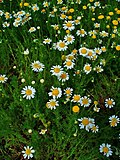Chamomile
Chamomile (KAM-ə-meel or KAM-ə-myl),[1] also known as camomile, is a plant from the genus Anthemis.[2] Its name comes from the Greek word chamaimelon, meaning "ground apple", because of its smell.[3] It has white or yellow flowers, and over 100 species.[2] It can be used as a medicine or as tea.[4] It has been shown to make rodents feel calmer,[5][6] and helps make people less stressful.[7] It is the national flower of Russia.
Chamomile Media
German chamomile, Matricaria chamomilla
Roman chamomile, Chamaemelum nobile
References
- ↑ "Chamomile | Define Chamomile at Dictionary.com". reference.com. Retrieved 19 August 2010.
- ↑ 2.0 2.1 "chamomile (plant) -- Britannica Online Encyclopedia". britannica.com. Retrieved 19 August 2010.
- ↑ "Online Etymology Dictionary". etymonline.com. Retrieved 19 August 2010.
- ↑ "Chamomile - What You Need to Know About Chamomile". about.com. Archived from the original on 4 December 2010. Retrieved 19 August 2010.
- ↑ Brown E, Hurd NS, McCall S, Ceremuga TE (October 2007). "Evaluation of the anxiolytic effects of chrysin, a Passiflora incarnata extract, in the laboratory rat". AANA J. 75 (5): 333–7. PMID 17966676.
{{cite journal}}: CS1 maint: multiple names: authors list (link) - ↑ Wolfman C, Viola H, Paladini A, Dajas F, Medina JH (January 1994). "Possible anxiolytic effects of chrysin, a central benzodiazepine receptor ligand isolated from Passiflora coerulea". Pharmacol. Biochem. Behav. 47 (1): 1–4. doi:10.1016/0091-3057(94)90103-1. PMID 7906886. S2CID 46508977.
{{cite journal}}: CS1 maint: multiple names: authors list (link) - ↑ "Discovery Health "Chamomile: Herbal Remedies"". health.howstuffworks.com. Retrieved 19 August 2010.




